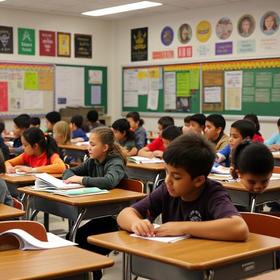The Arizona State Schools for the Deaf and the Blind is an Arizona state agency, with its administrative headquarters in Tucson.
Asdb - Region 3 ranks in the bottom 50% of all schools in Arizona for overall test scores (math proficiency is bottom 50%, and reading proficiency is bottom 50%).
The percentage of students achieving proficiency in math is 20-29% (which is lower than the Arizona state average of 45%). The percentage of students achieving proficiency in reading/language arts is 20-29% (which is lower than the Arizona state average of 45%).
Quick Facts (2025-26)
- School Type: Special education school
- Grades: Prekindergarten-12
- Graduation Rate: ≥50%
- Math Proficiency: 20-29%
- Reading Proficiency: 20-29%
- Source: National Center for Education Statistics (NCES), AZ Dept. of Education
School Overview
School Type
Grades Offered
Grades Prekindergarten-12
(No virtual instruction)
(No virtual instruction)
Total Students (19-20)
132 students
Total Classroom Teachers
n/a
Year Founded
1912
School Rankings
Math Test Scores (% Proficient)
(18-19)20-29%
45%
Reading/Language Arts Test Scores (% Proficient)
(18-19)20-29%
45%
Student-Teacher Ratio
n/a
17:1
American Indian
(19-20)5%
6%
Asian
(19-20)1%
3%
Hispanic
(19-20)54%
45%
Black
(19-20)3%
5%
White
(19-20)35%
38%
Hawaiian
(19-20)1%
n/a
Two or more races
(19-20)1%
3%
Graduation Rate
(18-19)≥50%
78%
Eligible for Free Lunch (19-20)
5%
43%
Eligible for Reduced Lunch (19-20)
1%
7%
School Statewide Testing
School District Name
Source: National Center for Education Statistics (NCES), AZ Dept. of Education
Frequently Asked Questions
What schools are Asdb - Region 3 often compared to?
Asdb - Region 3is often viewed alongside schools like Rillito Center, Dan Hinton Accommodation School by visitors of our site.
What percent of students have achieved state testing proficiency in math and reading?
20-29% of students have achieved math proficiency (compared to the 45% AZ state average), while 20-29% of students have achieved reading proficiency (compared to the 45% AZ state average).
What is the graduation rate of Asdb - Region 3?
The graduation rate of Asdb - Region 3 is 50%, which is lower than the Arizona state average of 78%.
How many students attend Asdb - Region 3?
132 students attend Asdb - Region 3.
What is the racial composition of the student body?
54% of Asdb - Region 3 students are Hispanic, 35% of students are White, 5% of students are American Indian, 3% of students are Black, 1% of students are Asian, 1% of students are Hawaiian, and 1% of students are Two or more races.
What grades does Asdb - Region 3 offer ?
Asdb - Region 3 offers enrollment in grades Prekindergarten-12 (No virtual instruction).
What school district is Asdb - Region 3 part of?
Asdb - Region 3 is part of Arizona State Schools For The Deaf And The Blind (6393).
In what neighborhood is Asdb - Region 3 located?
Asdb - Region 3 is located in the El Rio Acres neighborhood of Tucson, AZ. There are 5 other public schools located in El Rio Acres.
School Reviews
Review Asdb - Region 3. Reviews should be a few sentences in length. Please include any comments on:
- Quality of academic programs, teachers, and facilities
- Availability of music, art, sports and other extracurricular activities
Recent Articles

How Public Schools Support Students on Free / Reduced-Lunch Programs
Explore how U.S. public schools support students eligible for free or reduced-price lunch through nutrition, academic, and wraparound services in 2025.

Hidden Costs of Public Schools: Fees, Supplies & Extras
Explore the hidden costs in public schools—fees, supplies, extracurriculars—and how parents can plan for them in 2025.

Public School Funding 2025: What Families Should Know
Essential insights on public school funding in 2025—how it works, what’s changing, and what families should know to stay ahead.









